I am R. Hear me Rar.
 Derek & Laura Cabrera
·
5 minute read
Derek & Laura Cabrera
·
5 minute read
Rar-one of the most important ideas in systems thinking
If you are not new to systems thinking/DSRP, then you’ll be familiar with the use of silly puns and naming conventions. The term Rar is used as an acronym but also as a kind of funny moniker that aids memory and communicates its power. As in: “I am R, hear me Rar.”
In fact, one of the many insights that DSRP provides is that “nature often hides its secrets in the relationships.” This means that anything we can do to shine a light on the Rs, to zoom into the Rs, to remember to see the Rs, is a good thing. Moniker-devices such as Zooming Rs, RDSs, Barbells, and Rar’s help us "zoom into the Relationships" and see what is going on.
The other day, I received this note from a colleague (Scott Moehring):
I've been thinking about Relationships, and the co-implied elements of Action-Reaction. All of the other co-implied elements (Identity-Other, Part-Whole, and Point-View) make perfect sense to me. I understand how any idea or thing can be related to any other idea or thing. It's the basis for one of the key methods I teach for brainstorming. What I can't wrap my head around is how those relationships are all Action/Reaction. I've been playing with the idea of Connect/Affect instead. They seem to co-imply, as Affecting requires a Connection (otherwise, what's Affecting?), and you can't Connect things without them Affecting each other in some way. Connect-Affect seems more universal to me, particularly when there is no obvious Action/Reaction. I built an example in Plectica [see below]. These two women have the Relationship "sister". When I Connect them, they are both Affected in that each now has an identity of "sister" to the other. I'm struggling trying to understand that as Action-Reaction. Does Kirsten being a sister "cause" the "effect" of Tracy also being a sister?
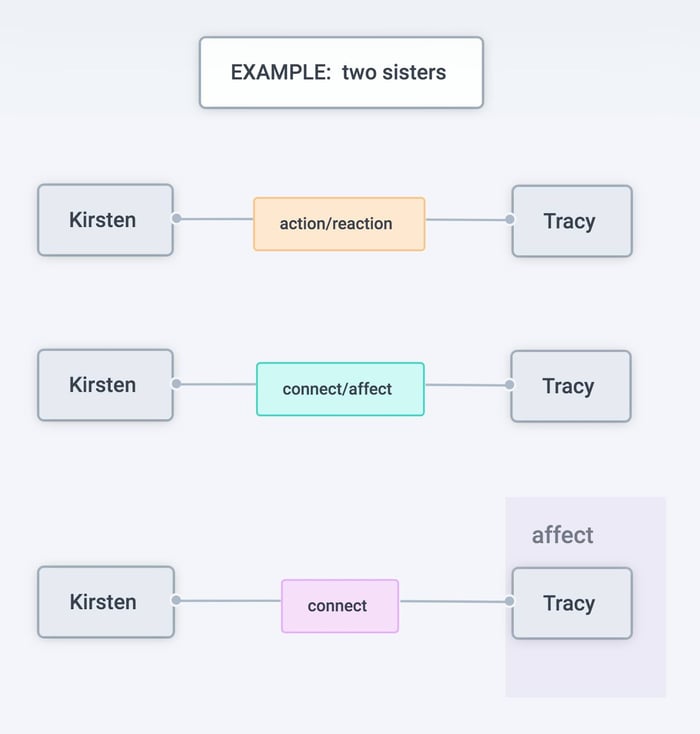
This kind of exploration of terminology is important. “Connect” is synonymous with "Relate" or Relationship (R), so to use Connect (or Link) as an element of Relationship would be somewhat redundant (see R synonyms poster). Indeed, we have used the terms affect-effect in place of action-reaction (this is a semantic replacement, not a meaningful one, as the meaning of these elements remains the same). The reason we don’t encourage use of these terms (especially affect) is because (1) it is grammatically incorrect making it sometimes difficult to describe in English without being criticized for misusing the language, and (2) the terms (especially affect) mean specific [and somewhat misleading] things in psychology. We have also used cause-effect, but no longer do, because the term “cause” has so many different implications in so many domains, none of which provide clarity to the meaning of Rar. If one uses the term cause in a discrete, linear way, they are meaning that A causes B to occur, and that is certainly not always what we are communicating when we are talking about action-reaction (although sometimes “cause” can be used to describe a relationship that is indeed causal (e.g., A causes B to occur)).
His question continued:
With only two months of experience playing with these ideas, I know I can only see the tip of the iceberg. Can you help me understand what I'm not seeing about why Action-Reaction are the preferred Relationship elements? Bonus points if you can help me understand why Connect-Affect isn't more universal.
This is a great question, and without a doubt one of the things that many people misunderstand, misinterpret or misuse about DSRP. First, the a-r structure of R is super basic and also massively important for understanding systems (especially developing an advanced understanding of the micro relations between physical systems or the dynamical micro interactions that occur in human social dynamics).
Second, think of the R-a-r structure as no different (conceptually) from Newton’s Third Law but applied universally across any type of system (physical, conceptual, etc.). Put simply, when two things relate (say two skaters or two ideas) skater A and skater B take action (green arrows) upon each other and exhibit a reaction (blue arrows) to each other.
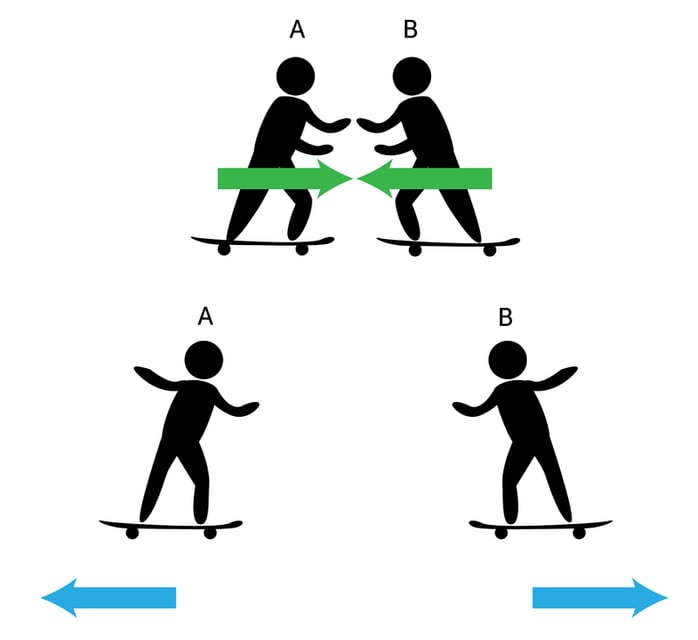
It is easy to see what this looks like in the physical realm with skaters, etc. but what does this look like in the conceptual or human dynamics realm? Let’s look at two ideas: LAB and COAT. What color is the coat? [I’ve asked this question to thousands of audiences and they always say the same answer:] White. The coat is always white. Why? Because when two ideas are put into the same conceptual space, our mind wants to relate them. When our mind relates them, there are actions and reactions because, well, because Rar. So, LAB has a LAB-like action on COAT and COAT has a COAT-like action on LAB. In turn, COAT and LAB both react to this action and take on new meaning.

Over time (which conceptually may be measured in milliseconds), the conceptual elements (parts, etc) of the concept LAB influence the concept COAT and therefore cause it to lean toward the white, cotton, button down, pocket protector variety of COAT.
Try this: add a third concept. DOG

Now what color is the coat? What is it made of. In many years of doing this “thought experiment” people will go one of two ways: (1) they'll think of a dog’s coat and the concept LAB will take on the properties of a LABRADOR or (2) the coat will remain a white lab coat and the concept DOG will be invited into the conceptual space and the story will be that a scientist wearing a white lab coat is working with dogs in the laboratory.
In both of these cases Rar is at work, creating a cascade of micro-action/reactions that cause a conceptual “collapse of the wave function” leading to the concept formation as LAB or LABRADOR, LAB COAT or DOG COAT. In this sense, the concepts, COAT, LAB, and DOG act akin to coupled-oscillators (green) that “get in sync” with each other over many iterations at millisecond time scales.
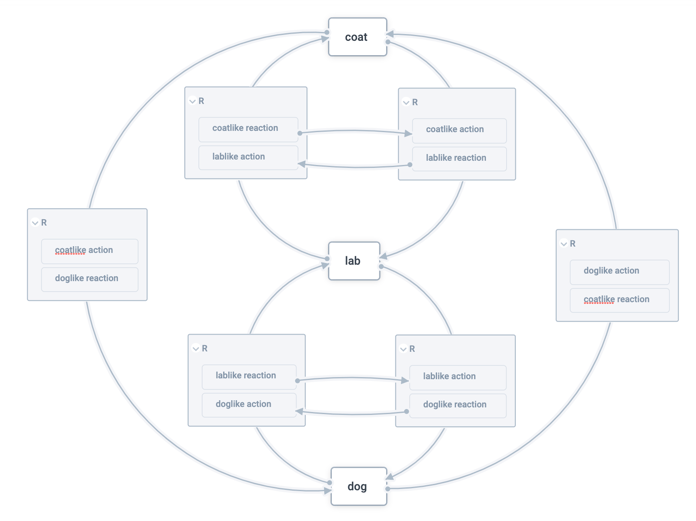
But the same conceptual interactions could occur psycho-socially at macrotime scales (days, weeks, years) as in the example of the forming of definitions like “torture,” terrorist,” “enemy combatant,” “marriage,” etc. And the same real-world inter-action occurs in answering the question: “Does Kirsten being a sister "cause" the "effect" of Tracy also being a sister? “ the answer is yes. The moment Kirsten is born she becomes a daughter and her Mother becomes a mother. She and Tracy also became sisters. All of these things affected their identity.
The benefits of Rar go far beyond concept formation. Rar has profound implications for psychological and sociological phenomena such as human dynamics, intra- and interpersonal understanding, metacognition, self-reflection and awareness, and communications such as active listening, conflict resolution, mediation, and cognitive behavioral therapy (CBT), etc. We call this the “R-quad”
Whether you're an armchair psychologist, interested in your own DIY self-development, or a professional therapist, what knowing Rar causes is for you to never look at a system like the one below the same again:

Instead of simply seeing two things interacting, you’ll instead see this system like this:

This latter system is extremely dynamical, and describes human conflict, triggering, and healthy dispositions (among many other things). The basic idea is that A exerts itself in the world existentially (this might be by speaking, acting, behaving, or just sitting, being). A is an extension of itself. The same is true for B. When A and B get into proximity with each other (like otherwise inert chemicals can become combustible when they interact) they begin to interact. A has an A-like action on B and vice versa. B in turn has a B-like action on A. This is enough to resolve many conflicts and understand many misunderstandings. But we can take it a step further, because Rar is fractal, we can look at the internal R between actions and reactions (say within A or within B) like this:
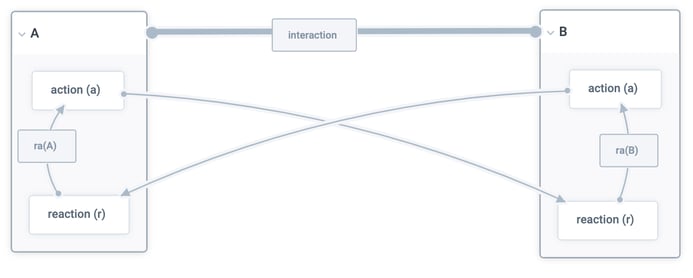
What this means is that we become aware of our internal processing and therefore can have more choice and some control of how we react. In other words, we can SEE our reactions to things before they become outward reactions. Most importantly, we can convert those autonomic reactions into purposefully chosen actions. When someone throws a punch, we do not have to automatically react and return the punch, instead we can decide whether to “turn the other cheek” or send an unexpected kick to the groin. This metacognitive pause makes all the difference. It can diffuse a heated situation, inform honest communication, and ultimately improve relationships between and among all of us. It also makes it clear that much of the work to be done in INTER-personal relationships is INTRA-personal.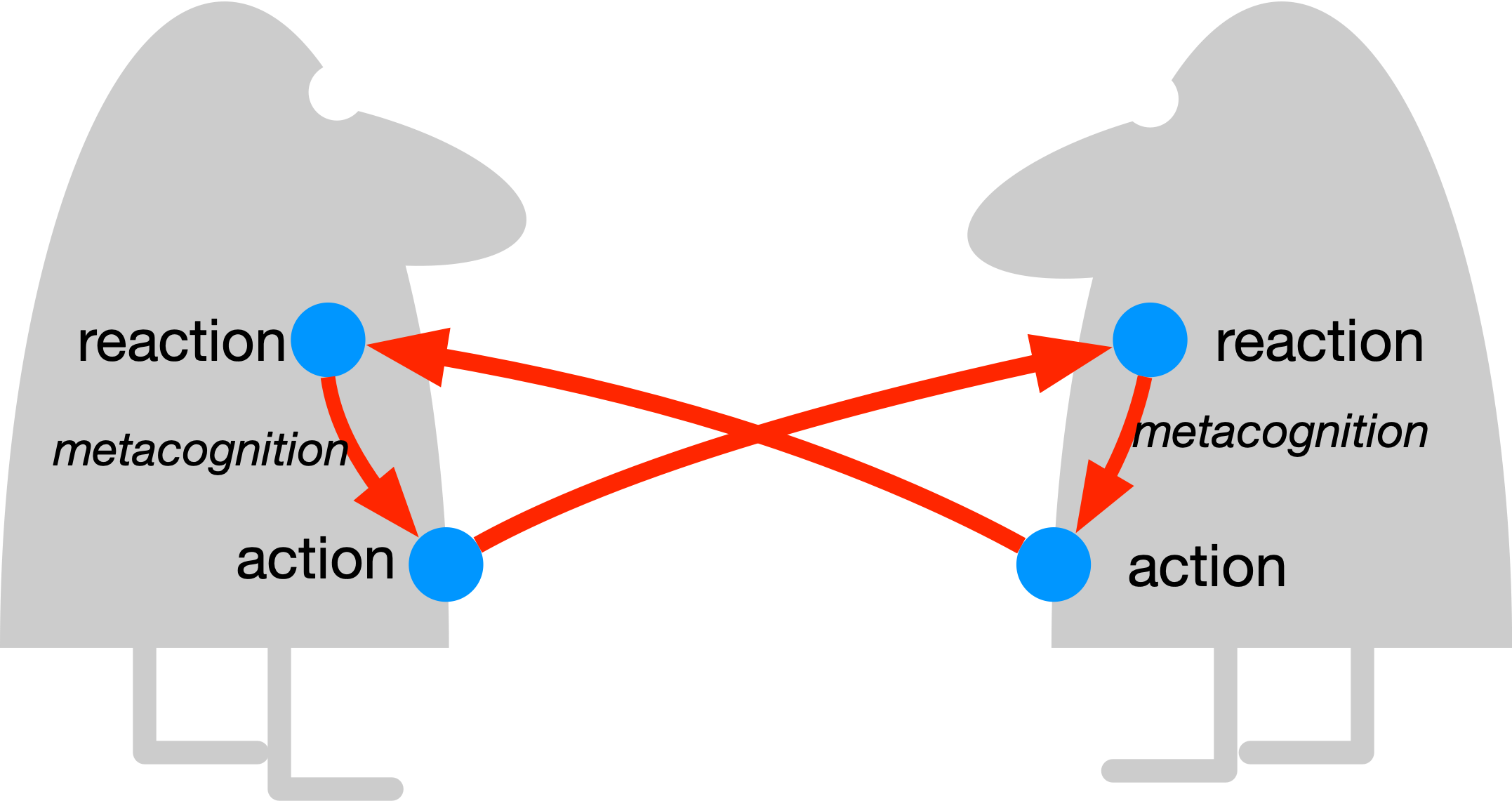
Let us know how we did on the bonus points...?
.png?width=150&height=150&name=CRL%20GOAT%20Logo%20(4).png)


